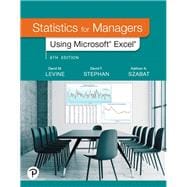For one-semester courses in Introduction to Business Statistics.
This is the 18-week standalone access card for MyLab Statistics.
The gold standard in learning Microsoft Excel for business statistics
Statistics for Managers Using Microsoft® Excel®, 9th Edition helps students develop the knowledge of Excel needed in future careers. The authors present statistics in the context of specific business fields, and now include a full chapter on business analytics. Guided by principles set forth by ASA’s Guidelines for Assessment and Instruction (GAISE) reports and the authors’ diverse teaching experiences, the text continues to innovate and improve the way this course is taught to students. Current data throughout gives students valuable practice analyzing the types of data they will see in their professions, and the authors’ friendly writing style includes tips and learning aids throughout.
The book also integrates PHStat, a statistical add-in that bolsters the functions of Excel. Extensive instructor and student resources are provided, including two online-only chapters, as well as the Digital Cases referenced in the text.
Personalize learning with MyLab Statistics
By combining trusted author content with digital tools and a flexible platform, MyLab Statistics personalizes the learning experience and improves results for each student. With MyLab Statistics and StatCrunch® integrated web-based statistical software, students learn the skills they need to interact with data in the real world.
0135970245 / 9780135970249 MYLAB STATISTICS WITH PEARSON ETEXT -- ACCESS CARD -- FOR STATISTICS FOR MANAGERS USING MICROSOFT EXCEL (18-WEEKS), 9/e











